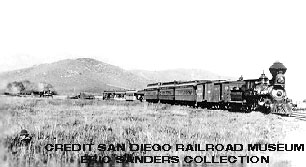The Southern California land boom of the 1880's brought about the building of several local railroads in the San Diego area. One, the San Diego, Cuyamaca & Eastern, was formed with the idea of building a railroad from San Diego and over Warner's pass to a connection with other roads from the east.
Started in 1886, the line was built to Lakeside by March 30, 1889. 3.3 miles more were built in 1889, extending the line to Foster, which became the permanent terminal.
The Cuyamaca line with its sharp curves and steep grades began at 9th and "N" (now Commercial) streets and ran out "N" Street, through Mount Hope Cemetery, Encanto, Lemon Grove, La Mesa, El Cajon, Santee, and Lakeside to Foster. The line's steepest gradient is on Commercial Street, where it gets up to 3.5% between 16th and 17th streets.
Not quite as steep, but more taxing on motive power, is the 2.88% grade westward between El Cajon and Grossmont. This grade is longer and has several curves which make train friction quite a problem.
The Line was merged with the San Diego Southern in March, 1912, to form the San Diego and Southeastern Railway. A few years later in 1917, the SD&SE became a part of the San Diego and Arizona Railway.
Like other lines in the county the Cuyamaca was hard hit by the 1916 floods. Portions of the line betweeen Santee and Foster were demolished. That part of the line between Lakeside and Foster was abandoned at that time.
During the 1920's the line ran eight passenger carrying trains. Some ran to Lakeside, while others were turned at La Mesa. Most schedules were operated with General Electric gas-electric cars with at least one mixed steam train besides.
The gas-electric car service began in 1916 by the San Diego and Southeastern, running nine round trips daily. The cars were operated from First and Broadway to Lakeside. The cars were numbered 41, 42 and 43. Numbers 41 and 42 were purchased from the Minneapolis, Northfield and Southern, with Number 43 coming from the Buffalo, Rochester and Pacific Rrailway.
Gas-electric's lasted up into the 1930's on the Cuyamaca and were often used in race train service on the SD&AE operating to Agua Caliente.
To provide better service in the San Diego area the route up First Avenue was soon extended to B Street and then to the Santa Fe station at Kettner and B. The gas-electric service on First Street lasted until 1930, when the cars were rerouted onto S.D.&A.E. trackage to the Santa Fe station.
Motive power used on the line for freight service varied over the years using ten wheelers, eight wheelers and finally ending up with a leased Southern Pacific mogul, number 1629, in February, 1951.
Freight service after World War II was reduced to a tri-weekly basis, with service on Tuesday, Thursdays, and Saturdays. Leased SP 70-tonners carried on after the end of steam. The small General Electric diesels turned in many miles of hard service on the Cuyamaca's steep grades. By 1960, the traffic had again became too heavy to handle on a tri-weekly basis. With many new industries on the line and a mile extension to the Montgomery Ward wharehouse in 1961, service became more frequent, usually averaging 5 days per week.
Today the 70-tonners are gone, having been replaced with EMD SW-8's. These 800 h.p. units are equipped with dynamic braking which is a blessing on the lines steep grades.
Service to Lakeside was cut back to Santee in 1939, and cut back further to Main Street in El Cajon early in World War II. With the recent extensions serving Montgomery Ward and the Overmyer Warehouse, the line now reaches the southern limits of Gillespie Field. We wonder if someday trains might not once more whistle into Santee and Lakeside.


 Back to the Railway History Page
Back to the Railway History Page
